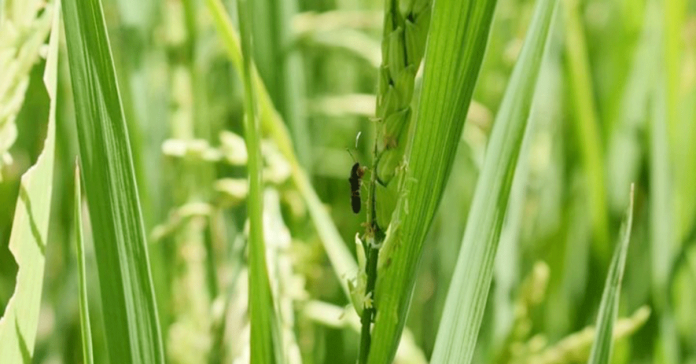
ILOILO City – Rice grain bugs (RGB) can infest rice fields, especially in rain-fed and upland areas. Farmers must know how to get rid of them.
Two weeks ago, RGB ravaged hectares of farmlands in Himamaylan, Negros Occidentals, according to Ryan Rasgo, chief of the Department of Agriculture – Western Visayas’ Regional Crop Protection Center (RCPC). This was the second area infested this year next to Barbaza town in Antique province where around 548 hectares rice areas were affected.
“Farmers must learn how to manage this pest. There are strategies to eradicate or lessen RGB infestation,” Rasgo told Panay News.
First, observe the fallow period and synchronous planting to break the pest cycle, Rasgo said.
In Western Visayas, the fallow period usually falls during the dry season (April to middle of May) where water is scarce. However, some areas that are fully irrigated may continuously plant rice.
The RCPC is open to all farmers who seek free logistical and technical support relative to RGB infestation and other pest-related concerns.
“We are ready to provide technical assistance and interventions,” said Rasgo.
Specifically, Rasgo said RGB attack time is during milk grain development. The bugs feed themselves from the milk grain.
“Kon indi synchronous planting, meaning indi dulolongan, ang 10 days nga window period nga may ara sia (bugs) kaunon, pagkatapos ya kaon sa portion nga ina, pwede naman masaylo sia sa unhan nga may manug-gatas gatas naman nga rice. Amo na ang danger kon wala nagadungan ang cropping sa isa ka lugar,” Rasgo explained.
Likewise, water management or flooding the rice field is another useful method to eliminate or at least minimize the RGB population.
“Ang direct nga makapatay sa iya para indi sia magdamo is water kay naga-itlog ni sia sa duta. So once may infestation, insigida dapat patubian sang farmer para ang mga itlog sa duta mapatay. Nagasaka lang ni sila sa humay kon gakaon na sila,” he added.
Infested rice field, right after harvest, must also be flooded with water or plowed right away, “para indi na madala ang mga eggs kag mga newly-hatched grain bug sa next cropping season.”
Moreover, Rasgo said they also recommend the use of biological control agents like metarhizium and beauveria fungi as well as fungicides.
“Ang effect ya sina, nagamasakit ang rice grain bugs. Ginatuboan sang amag. Indi abrupt nga mapatay sila dayun. Mga three to four days pa ang effect,” Rasgo furthered.
Formerly tagged as the “new pest of rice,” the first RGB incidents in the region were recorded in Sipalay City and adjacent towns in Negros Occidental back in 2017. Similar pest infestation also occurred in the 10-hectare rice fields in Janiuay, Iloilo late last year.
Rasgo said RGB is uncommon in plot irrigated areas.
Agricultural extension workers in the region are advised to hold constant monitoring activities to allow early detection and appropriate management of crop pests.
Rasgo also emphasized that the use of synthetic chemicals to destroy the RGB hosts should be treated as a last resort.
For the second quarter of this year, farmers are also on the lookout against rats, especially when the harvest season is nearing.
“Kag kon may mag adbinturar nga mag-third crop gid man, ilaga na lang ang main concern kay diutay na lang ang kalan-on nila. Ang volume sang ila ma-punsok gid sa ila mga talamnan. The rest nga mga pest during regular season, wala na sila basta amu ni nga summer. In general, basta mainit ang panahon, laka ang mga pests,” said Rasgo./PN





